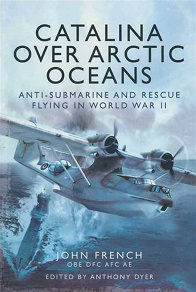
Isbn:
978-14-7381-301-4
Förlag: Pen and Sword
Kategori:
Memoarer & Biografier Samhälle & politik Historia
Tillgänglig sedan: februari 2021
Förlag: Pen and Sword
Kategori:
Memoarer & Biografier Samhälle & politik Historia
Tillgänglig sedan: februari 2021
E-bok
Catalina over Arctic Oceans
John French first took up flying in 1937 with the University of London Air Squadron and in 1938 joined the Royal Air Force Volunteer Reserve. His early war years were spent instructing newly recruited RAF pilots on Airspeed Oxfords and Avro Ansons. When the end of this posting came through he was designated to 210 Squadron at Sullom Voe in the Shetlands to fly the Catalina flying boat. In November 1942 the squadron was ordered south to join 202 Squadron at Gibraltar.
Here they flew sorties in support of the North African landings – Operation Torch. These were lengthy flights out into the Atlantic approaches to Gibraltar or Eastwards into the Mediterranean. He flew fifteen sorties in this short period before returning to Pembroke Dock. He was then instructed to report to Felixstowe to collect Catalina IB FP 222 and to ferry it up to his new base Sullom Voe.
From this northern base the flying boats flew thirty hour patrols out into the Northern Atlantic searching for enemy ships and U-boats. On 8 September he was ordered to execute an extended search of the Norwegian coast where it was thought that the Tirpitz and Scharnhorst were seeking shelter. Having unsuccessfully searched the entire coastline at low-level they finally touched down on the Kola Inlet after a flight of over twenty-two hours.
As February 1944 came towards its end he was detailed to cover a Russian convoy, JW57, far up to the north of the Arctic Circle. Shortly before his ETA with the convoy they got a radar return. They dropped down below the cloud to find a rough angry sea and spotted the wake of a ship. However this was not a ship but a surfaced U-boat. As they flew into attack they met a hail of 37mm and machine-gun fire John dropped to attack level and came in from the stern dropping two depth charges. Thus came the demise of U-601.
On 18 July 1944 a Liberator of 86 Squadron was set
on fire during an attack on a U-boat and was forced to
ditch some 100 miles west of the Loften Islands. Eight
members of the crew took to their dinghies. A Catalina
was despatched on a search and rescue mission the
following day but failed to find the victims. However on
20 July they were resighted. A volunteer crew was
hastily formed and took off at 0130 on the 21st. Some
excellent navigation brought the survivors into view at
ETA. John decided to attempt a sea landing to effect the
rescue. He came in low, into wind and across the swell
at 65 knots. His crew soon had the stranded airman
aboard, somewhat bedraggled after their sixty-two hour
ordeal. They landed back at Sullom at 1410.
After the war John stayed in the RAF and spent much of
his time behind the Iron Curtain.
Here they flew sorties in support of the North African landings – Operation Torch. These were lengthy flights out into the Atlantic approaches to Gibraltar or Eastwards into the Mediterranean. He flew fifteen sorties in this short period before returning to Pembroke Dock. He was then instructed to report to Felixstowe to collect Catalina IB FP 222 and to ferry it up to his new base Sullom Voe.
From this northern base the flying boats flew thirty hour patrols out into the Northern Atlantic searching for enemy ships and U-boats. On 8 September he was ordered to execute an extended search of the Norwegian coast where it was thought that the Tirpitz and Scharnhorst were seeking shelter. Having unsuccessfully searched the entire coastline at low-level they finally touched down on the Kola Inlet after a flight of over twenty-two hours.
As February 1944 came towards its end he was detailed to cover a Russian convoy, JW57, far up to the north of the Arctic Circle. Shortly before his ETA with the convoy they got a radar return. They dropped down below the cloud to find a rough angry sea and spotted the wake of a ship. However this was not a ship but a surfaced U-boat. As they flew into attack they met a hail of 37mm and machine-gun fire John dropped to attack level and came in from the stern dropping two depth charges. Thus came the demise of U-601.
On 18 July 1944 a Liberator of 86 Squadron was set
on fire during an attack on a U-boat and was forced to
ditch some 100 miles west of the Loften Islands. Eight
members of the crew took to their dinghies. A Catalina
was despatched on a search and rescue mission the
following day but failed to find the victims. However on
20 July they were resighted. A volunteer crew was
hastily formed and took off at 0130 on the 21st. Some
excellent navigation brought the survivors into view at
ETA. John decided to attempt a sea landing to effect the
rescue. He came in low, into wind and across the swell
at 65 knots. His crew soon had the stranded airman
aboard, somewhat bedraggled after their sixty-two hour
ordeal. They landed back at Sullom at 1410.
After the war John stayed in the RAF and spent much of
his time behind the Iron Curtain.
Logga in för att låna
Information
Stöds av följande plattformar
PC/Mac
Surfplatta Läsplatta
Smartphone
